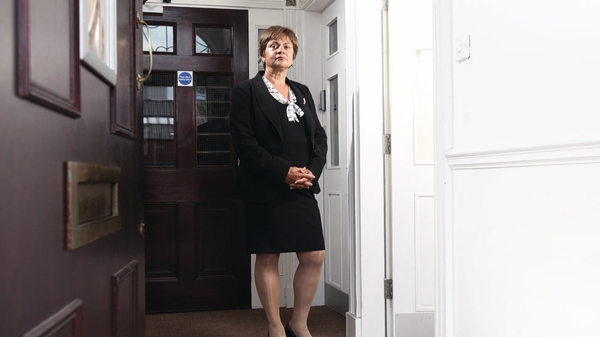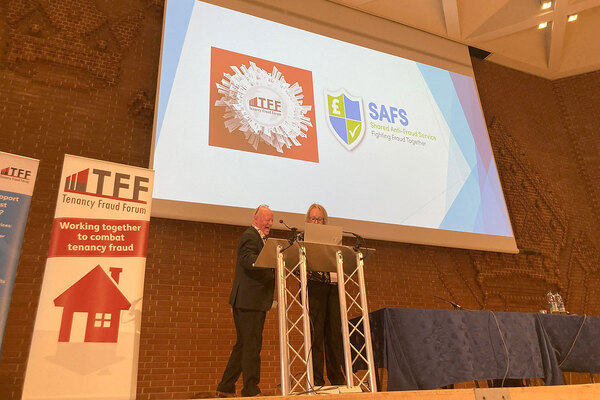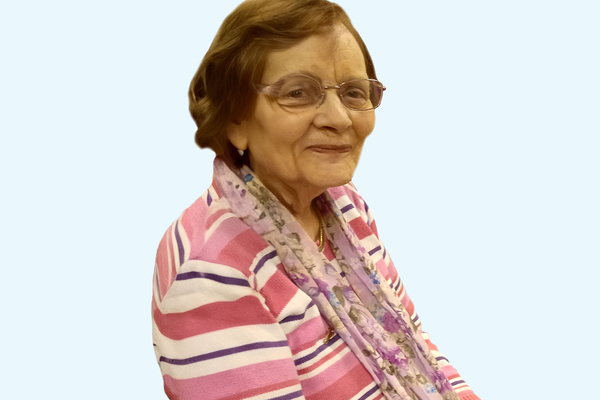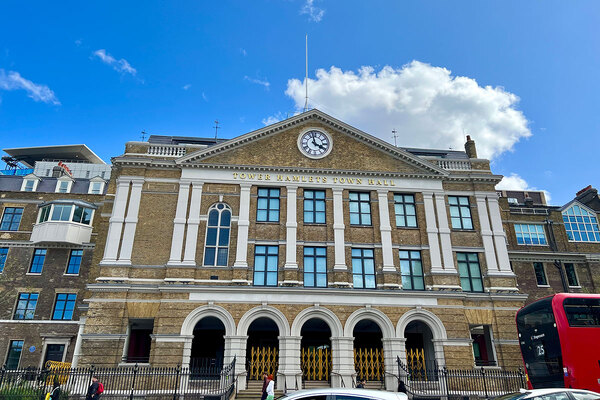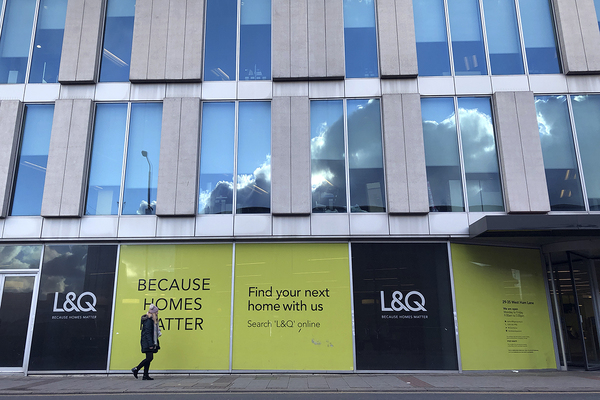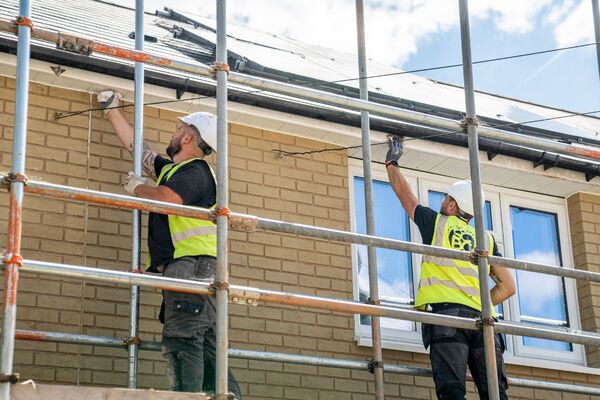You are viewing 1 of your 1 free articles
Pride and prejudice
Controversy erupted this summer over homes prioritised for older Asian tenants. But is the hand-wringing justified? Reni Eddo-Lodge visits a retirement community that has black tenants’ needs at the centre of its approach
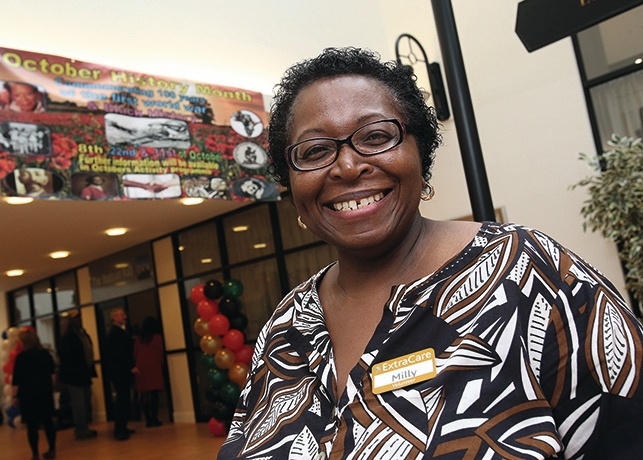
Millicent Gobbinsingh, who organised Black History Month at the Village
Pannel Croft retirement village is celebrating Black History Month. An exhibition of West Indian flags hangs on the walls. Books on black history are dotted about. And the event is catered with traditional Caribbean foods.
The organiser of today’s celebration, Millicent Gobbinsingh, is 62. ‘As soon as I came in and looked at one of the show room apartments, I thought ‘This is for me. When you come in here, it’s like a family in a sense’
She sold her house in Birmingham in order to move into Pannel Croft Village, a smart white new build development, with honey-coloured flagstones outside and a giant chess set to keep residents’ brains active in the fresh air.
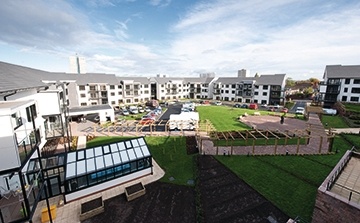
The exterior of Pannel Croft
The village has been in operation since 2012 and is one of 14 retirement villages operated by Extra Care Charitable Trust across the Midlands and the north of England. Residents live in one- or two-bedroom flats, and each corridor on each floor has its own street name – Amazon Walk and Clyde Street, to name a couple. Residents decorate the front of their flats with welcome mats and porcelain animals.
There’s a feeling of familiarity as residents greet each other in passing. The flats combine affordable rent apartments, and shared ownership properties for the 200 residents.
It’s not an ethnicity-specific retirement home, but more than 70% of the village’s residents are black and minority ethnic (BME). Its demographics are a reflection of the demographics of the area; 70% of Aston New Town’s population is BME. Situated just outside the city centre, it was immigration from the Commonwealth that swiftly changed the demographics of the area in the 1950s and 1960s.
Millicent explains why this is important to her. ‘I’m associating with the same people who used to be in my community, and the community is still there,’ she stresses. ‘I don’t need to stay in, I can still go to the shop, I can still see my friends. There’s nothing really that is different.’
So what’s the controversy? Inside Housing has come to Pannel Croft to investigate whether housing for older people that is designed with BME residents in mind has something special to offer. In July of this year, the question of BME housing, and specifically for older people, erupted unexpectedly into brouhaha. Residents of Chatham, in Kent, had caught wind of advertisements for Orbit Housing Group’s Apni Haweli, a supported housing scheme for older people. Rent for the flats was £77.70 a week, central heating was listed as a perk, and preference for the flats was given to Asian applicants.
Online vitriol
Angry comments ensued. After reporting on the Apni Haweli controversy, the Facebook page for local paper the Medway Messenger was home to most of the vitriol. Local resident Leighann Charlotte Felstead wrote: ‘I and a lot of others think this is disgraceful. This wouldn’t be allowed if it was written as priority to white community. Surely this is discrimination.’

The roof terrace of Pannel Croft
The anger online soon took a sinister turn. Talk of reverse racism opened up a window of opportunity to the far right, and nationalist group Britain First capitalised on it. Orbit Housing found itself on the receiving end of an organised hate campaign of more than 700 emails and social media posts. Writing about Apni Haweli on its blog, the Scottish wing of the British National Party said: ‘What are these people doing in our country in the first place if they can’t speak English?’
Adding fuel to the fire, former housing minister Kris Hopkins passed comment on the controversy. ‘People want to see fair play, and social housing should be allocated to local people based on need’, he said. ‘Whatever the original intent, I am concerned that any housing policy based on race will undermine good community relations and harm integration. This is a classic example of the gold-plating of equality rules doing more harm than good.’
Replying to Apni Haweli’s detractors in the pages of Inside Housing, Orbit Group chief executive Paul Tennant wrote: ‘This type of prejudice has no place in a fair, modern society and we will not be intimidated by people like this. Orbit has not acted incorrectly or illegally.’ He continued: ‘Orbit’s mission is building communities and we are proud to provide homes for people of all backgrounds, like this particular scheme for a mixed group of older people.’
There has been a need for BME housing since the Windrush generation settled in the UK, and the controversies surrounding such associations and organisations have ebbed and flowed.
The first BME-led housing associations in the UK originated in the 1960s, when immigration led landlords to hang ‘no blacks, no dogs, no Irish’ posters up in the windows on properties up for rent. There are currently more than 65 BME housing associations across Britain. Most of these housing associations are members of advocacy group BME National. Once named the federation of black housing organisations, the group downsized in 2008 and now sits inside the National Housing Federation.
Cym D’Souza is the chair of BME National’s executive, as well as the chief executive of Manchester’s Arawak Walton Housing Association. She says people who are in need of BME housing are predominantly first and second-generation immigrants. ‘Those who had come across in Windrush, and then later on in terms of Asian communities in the 1970s were reaching pensionable age, and there wasn’t an appropriate level of accommodation that dealt with their needs in terms of sheltered housing.’
But since the millennium, the BME housing sector has been shrinking. Public amenities earmarked for under-represented groups are dogged by accusations of separatism, favouritism and special treatment. While the 2010 Equality Act enshrines equal treatment on the basis of race in UK law, social attitudes continue to lag behind.

A visitor at the Black History Month exhibition
New models
Back in Birmingham, however, the question of why and whether to specifically cater for BME residents has not provoked such a crisis of confidence. Instead, Extra Care explains, it comes from recognition that existing models for retirement communities wouldn’t work for all residents.
‘The main population base in this part of Birmingham is either black Caribbean or white Irish, so we had to question if our [retirement village] model was going to work,’ explains Nick Abbey, Extra Care’s chief executive.
‘The sort of things we had been producing in Warrington and Nottingham wasn’t going to work here. From my experience of working in housing associations, I think we’ve evolved a particular style of accommodation, particularly older persons’ services, that’s based on a white British experience.’
Angela Barker, Pannel Croft commissioning and healthy lifestyle director, explains ‘We didn’t define a target regarding ethnicity – but we did ensure that all local older peoples groups of all ethnicities were aware of the project. The impact of this has resulted in the current resident profile.
‘In addition, we did prepare a strategy in relation to how we consulted with the local population and how cultural needs would be met in the village. For example, ensuring that a African Caribbean hairdresser would be available on site and that menus would reflect the cultural needs and wishes of the resident population.’
Ms D’Souza agrees. Speaking of housing associations for older people that don’t take the time to cater to BME needs, she points out: ‘You might have the one lone BME person who’s quite isolated from the other residents because of their slightly different background and culture. Where older BME people are living in areas where there is a significant majority of BME people, to suddenly find themselves in a place that’s predominately white can feel a bit alienating.’
Before joining Pannel Croft Village two years ago, manager Julie Talbot managed a similar Extra Care village in Litchfield, Staffordshire. ‘Litchfield is a predominately white, middle class, affluent city in Staffordshire,’ she said. ‘Most of the residents there had sold their homes and were leaseholders in the village. They had a good standard of living and a high level of disposable income.’
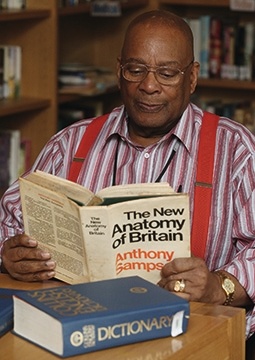
Pannel Croft resident George Gordon
Reflecting on her time at Pannel Croft, she says: ‘I have noticed that some of the day-to-day needs are quite different. People here have quite high levels of debt, and health problems are exacerbated. Instances of sickle cell and diabetes are far higher.’
Research from Diabetes UK shows that 6% of UK adults have been diagnosed with diabetes, and figures from the Department of Health show that type 2 diabetes is up to three times more common among those of African and African-Caribbean origin. Of the 205 residents living in Pannel Croft Village, approximately 40% suffer from diabetes.
George Gordon, another Pannel Croft resident, moved to the UK from Jamaica when he was 16. Sixty years later, he has settled comfortably in the village. Paraphrasing the late Jamaican cultural theorist Stuart Hall, he says: ‘I am here because they were there. I am here because they took me from my motherland and carried me to the Caribbean. I am here because historically, my ancestors were used to build the wealth of this country.’
‘I feel more comfortable in an environment that is able to understand the way I dress, the way I speak, the food I prefer, the music I like. And has some historical understanding as to my journey, why I am here.’
Limiting outcomes
Common features that limit outcomes for ethnic minority groups in social care:
- reliance on community and kin-based networks limiting access to or distorting accurate information and advice;
- lack of awareness and understanding among service providers as to why different ethnic groups are not using or benefiting equally from services;
- experiences of racism and discrimination in some cases;
- fear or mistrust of mainstream services in some cases.
In places where one ethnic minority is dominant, services can be inclusive to that group but not to smaller minorities. English for Speakers of Other Languages (ESOL) not only improves language skills, but creates positive inter-ethnic networks, increasing cultural awareness and sharing information about services. Ethnic minority interviewees reported a better quality of service where agencies had a linguistically diverse workforce.
Source: Joseph Rowntree Foundation




